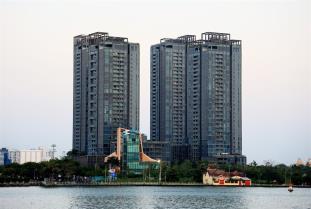Provincial mergers, which will reduce the number of provinces and cities in Việt Nam from 63 to 34, is not simply an administrative reform, but an opportunity to restructure the socio-economic space, according to the President of the Việt Nam National Real Estate Association (VNREA) Nguyễn Văn Khôi.

HÀ NỘI — Provincial mergers, reducing the number of provinces and cities in Việt Nam, from 63 to 34, is not simply an administrative reform, but an opportunity to restructure the socio-economic space, said President of the Việt Nam National Real Estate Association (VNREA) Nguyễn Văn Khôi.
The mergers will bring huge opportunities for urban development and have a positive impact on the real estate market, he said.
According to experts, the restructuring will accelerate the urbanisation rate, particularly in terms of transforming the real estate market in the Capital Region.
The Capital Region, including Hà Nội and nine neighbouring provinces of Hải Dương, Hưng Yên, Vĩnh Phúc, Bắc Ninh, Hà Nam, Hoà Bình, Phú Thọ, Bắc Giang, and Thái Nguyên, is identified as a socio-economic development linkage area.
Khôi said that in the near future, satellite urban areas will become the focal point of investment waves. Thanks to an increasingly complete connection infrastructure and abundant land funds, the localities neighbouring Hà Nội have proved a strong attraction in terms of investment capital.
According to data from the Việt Nam Real Estate Research Institute, the level of interest and investment in real estate in urban areas of the Capital Region increased sharply in the period of late 2024 and early 2025. This trend continued in the first quarter of 2025 when demand rose in areas along the Ring Road 4 and industrial corridors connecting Hà Nội with Bắc Giang, Hưng Yên and Hải Dương.
Clearly, cash flow and demand are shifting towards satellite cities, turning them into the centre of the market.
Such satellite cities have advantages in terms of large land funds and reasonable prices compared to Hà Nội’s inner areas.
At the same time, the improved inter-regional transport infrastructure has shortened the distance between Hà Nội and neighbouring provinces. A series of key projects have been implemented including Ring Road 3, Ring Road 4, inter-provincial expressways (Hà Nội – Hải Phòng, Hà Nội - Lào Cai, Hà Nội - Thái Nguyên) and the future urban railway system connecting the core area with the suburbs. Thanks to that, it is more and more convenient for people to live in Bắc Ninh, Hưng Yên or Vĩnh Phúc and work in Hà Nội.
In addition, escalating real estate prices, high population density and environmental pollution in the inner city of Hà Nội have inspired people to look to satellite cities for fresher, higher-quality living spaces. This trend not only helps reduce pressure on the city centre, but also opens up development opportunities for surrounding provinces.
The Vice President of VNREA and President of the Việt Nam Association of Real Estate Brokers (VARS) Nguyễn Văn Đính, assessed that real estate in the Capital Region is entering a period of strong transformation, towards sustainability, multi-functionality and inter-regional connectivity.
Hà Nội continues to be the growth engine, leading key areas such as finance - banking, logistics, innovation and start-ups. Meanwhile, satellite provinces are promoting the role of production - a logistics belt, providing premises, labour and supporting industrial services, especially for the high-tech sector.
After the process of merging administrative units and streamlining, the Capital Region will operate more flexibly and effectively, maintaining its contribution to the national GDP at 25-28 per cent by 2030.
Regarding infrastructure development, regional connectivity strategy is being clearly shaped. The belt routes connect the main axis of the whole region, while the expressway and inter-provincial metro are the connecting circuits of satellite cities. Public transport will be prioritised for development, creating faster and more convenient transport between Hanoi and neighbouring provinces.
An inter-regional real estate market will be formed, eliminating boundaries of localities, Đính added.
SGO Homes General Director Lê Đình Chung said that in the 2021 – 25 period, hundreds of thousands of billions of Vietnamese đồng have been invested into the transport system, opening up many new development opportunities.
In areas with completed and under-construction transport infrastructure, real estate values have recorded a stable growth rate of 15 – 20 per cent in just 12 months. In particular, the Hà Nội - Hưng Yên connection axis is witnessing a sharp increase in urbanisation, with real estate growth 1.5 times higher than the average of the market as a whole, becoming a new hot spot in the investment wave of the Capital Region.
The biggest advantage of emerging real estate markets is the large land fund. This is the key factor that helps localities attract major developers such as Vingroup, Ecopark, Phú Mỹ Hưng or Hoà Phát, who are participants in developing large-scale projects.
Moreover, the land price level in emerging areas is still competitive, between three and five times lower than in Hà Nội depending on the location and development potential. This creates a 'double opportunity' for both investors and buyers: helping businesses optimise project development costs while expanding access to housing for the majority of people, Chung said.
In addition, local authorities in many provinces and cities have also actively introduced preferential tax policies, supported investors in access to infrastructure and simplified legal procedures. The open investment environment contributes to shortening project implementation time and improving the efficiency of land exploitation in emerging markets.
With this advantage, the Capital Region is gradually becoming the new development belt of real estate in the North. — VNS
- Tags
- real estate





